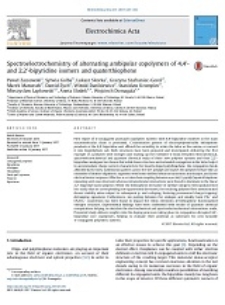Digital Library of the Silesian University of Technology contains 75 004 digital objects
Object
Title: Spectroelectrochemistry of alternating ambipolar copolymers of 4,4′- and 2,2′-bipyridine isomers and quaterthiophene
Creator:
Zassowski, Paweł ; Golba, Sylwia ; Skórka, Łukasz ; Szafaniec-Gorol, Grażyna ; Matussek, Marek ; Zych, Dawid ; Danikiewicz, Witold ; Krompiec, Stanislaw ; Łapkowski, Mieczysław ; Słodek, Aneta ; Domagała, Wojciech
Date:
Resource Type:
Title in Polish:
Abstract:
First report of π-conjugated push-pull copolymer systems with 4,4′-bipyridine moieties in the main macromolecular chain is presented. C-substitution pattern of electropolymerisable bithiophene pendants at the 4,4′-bipyridine unit offered the versatility to retain the latter as free amine, or convert it into bipyridylium salt. Both structures have been prepared and investigated, delivering the first example of a polymer with viologen unit making up the extended π-bond. Detailed electrochemical, spectroelectrochemical and quantum chemical study of these new polymer systems and their 2,2′-bipyridine analogues has shown that while linear structure and extended conjugation in the latter help it to accommodate charge carriers characteristic for heavily doped polythiophene, the conjugation break afforded by the meta substitution pattern across the 4,4′-pirydyl unit makes the polymer behave like an ensemble of shorter oligomeric segments with better defined electron transitions and sharper, and faster electrochromic response. Effective π-π interchain coupling between α,ω-bis(2-pyridyl)quaterthiophene repeating units was observed, whereas intramolecular interactions were found to dominate in the linear 2,2′-bipyridyl based polymer. While the bithiophene derivative of methyl viologen electropolymerised less easily than its corresponding non-quaternised derivative, the resulting polymer films demonstrated decent stability when subject to subsequent p- and n-doping, featuring pronounced charge trapping/detrapping signatures. Furthermore, ion pairing between the viologen and weakly basic PF6− and CF3SO3− counterions has been found to impact the redox chemistry of bithiophene functionalised viologen structure. Experimental findings have been confronted with results of quantum chemical computations helping to elucidate the electrochemical and spectroelectrochemical observations made. Presented study delivers insights into the doping processes taking place in conjugation disrupted 4,4'-bipyridine core copolymers, helping to evaluate their potential as substrates for new tuneable π-conjugated polymeric systems.
Comment:
Format:
Resource Identifier:
Baza Wiedzy PŚ ; oai:delibra.bg.polsl.pl:44986
Source:
Electrochimica Acta 2017 vol. 231, s. 437-452
Language:
Relation:
Faculty of Chemistry. Silesian University of Technology
Access:
Licence:
Object collections:
- Digital Library > COLLECTIONS OF PUBLICATIONS OF THE SILESIAN UNIVERSITY OF TECHNOLOGY > Publications from database "Bibliography of scientific publications of Silesian University of Technology"
Last modified:
Mar 19, 2018
In our library since:
Feb 11, 2018
Number of object content hits:
553
All available object's versions:
https://delibra.bg.polsl.pl/publication/49355
Show description in RDF format:
Show description in OAI-PMH format:
| Edition name | Date |
|---|---|
| Spektroelektrochemia naprzemiennych ambipolarnych kopolimerów izomerów 4,4'- i 2,2'- bipirydyny i kwatertiofenu | Mar 19, 2018 |
Objects Similar
Kurowska, Aleksandra Zassowski, Paweł Kostyuchenko, Anastasia S. Zheleznova, Tatyana Yu. Andryukhova, Kseniya V. Fisyuk, Alexander S. Proń, Adam Domagała, Wojciech
Kurowska, Aleksandra Kostyuchenko, Anastasia S. Zassowski, Paweł Skórka, Łukasz Yurpalov, Vyacheslav L. Fisyuk, Alexander S. Proń, Adam Domagała, Wojciech
Brzeczek, Alina Piwowar, Katarzyna Domagała, Wojciech Mikołajczyk, Mikołaj M. Walczak, Krzysztof Wagner, Paweł
Ledwoń, Przemysław Thomson, Neil Angioni, Enrico Findlay, Neil J. Skabara, Peter J. Domagała, Wojciech
Domagała, Wojciech Łapkowski, Mieczysław. Promotor Turek, Marian. Recenzent Zagórska, Małgorzata. Recenzent
Golba, Sylwia Łapkowski, Mieczysław. Promotor Kulszewicz-Bajer, Irena. Recenzent Turek, Wincenty. Recenzent
Słodek, Aneta
Łapkowski, Mieczysław




